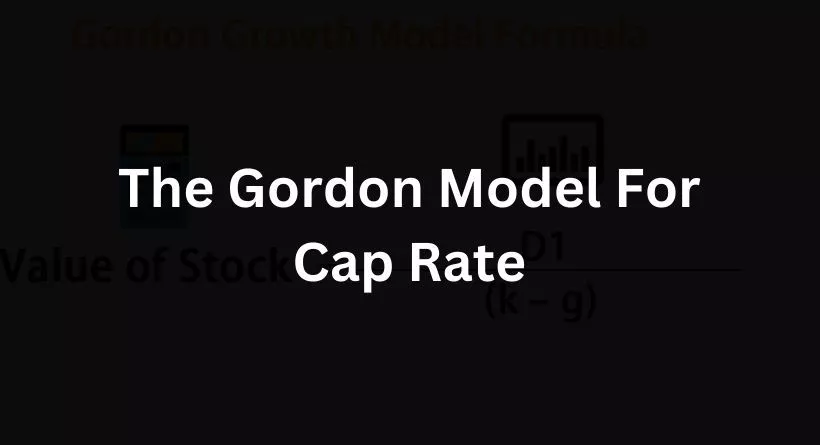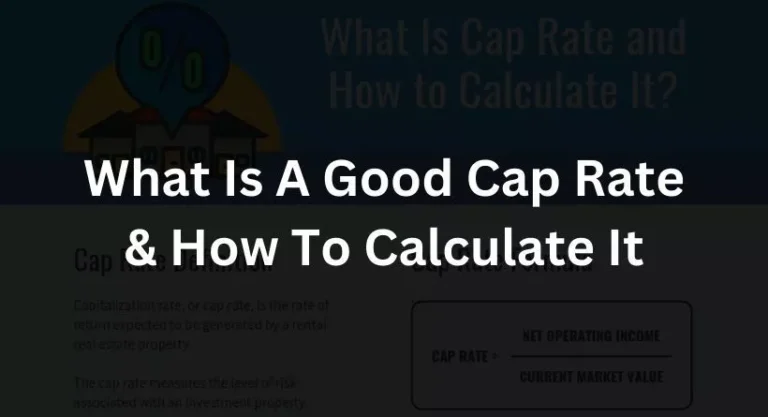A property’s cap rate, sometimes referred to as its capitalization rate, is one of the most crucial fundamental indicators for assessing its value. It should come as no surprise that cap rates have been crucial in creating some of the most successful real estate investment portfolios of the present, and there is no reason they couldn’t do the same for you. I’d even contend that you cannot create a portfolio that is even remotely respectable without considering “What is a good cap rate?” It’s that crucial. Therefore, it’s in your best advantage to comprehend cap rates better and learn how to use them in your investing strategies.
What Is Cap Rate?
One of the simplest and most reliable methods to determine whether or not an investment agreement is worthwhile is by looking at the cap rate. A cap rate, in its most basic form, is just a calculation that determines how much an investor stands to gain or lose if they decide to purchase the subject property. It is important to keep in mind, though, that a cap rate will only provide investors an estimate of how much they stand to make.
Cap rates have a built-in degree of inaccuracy, therefore they should be treated with caution. As a result, they are no more accurate than stock market forecasts. Again, cap rates are just used to predict one’s possible return on investment; they are not 100% correct. Having said that, a cap rate that has been accurately determined and is supported by thorough research and close attention to detail is priceless.
Cap rates should be utilized in combination with other measures rather than as a stand-alone indicator. A cap rate on its own is essentially pointless. The amount of risk that an investor may be exposed to during the course of an investment can be greatly reduced by a cap rate with more data and knowledge, though.
When to Use or Not Use a Cap Rate
You can use a cap rate to guide your decision-making when considering whether to buy two nearby comparable properties that are identical to one another. You should naturally infer that one asset has a larger risk premium if one property’s cap rate is 6% and another’s is 12%. Cap rates can also be used to predict market direction.
Why Does It Matter For Investors?
CoinMarketCap experts advise investors to “understand the cap rate since it might be significant in understanding the quality of a possible investment. Cap rates are neither a magic formula nor a flawless statistic by which an investor may make an investment decision in isolation, but they can aid investors in making the best choices for their portfolio when incorporated as a primary indicator among several formulations and views.
The advantage of understanding the cap rate is that the resulting figure may reduce risk in more ways than most investors are aware of. It makes sense that if you are aware of the prospective return on investment, you will be able to decide whether or not to proceed with the purchase.
How To Interpret Cap Rate
We’ve proven the significance of cap rate, but what does it mean in practice? At first look, it could appear complicated, but evaluating an investment’s quality by its cap rate is fairly easy. We must first establish that a cap rate is determined as though the property were bought outright with cash rather than if a loan was used. Having said that, the cap rate is only the yield an asset will provide over a year. In other words, this is the rate of return you may expect from the property.
How to Estimate Property Value Using Cap Rate?
A real estate investor carefully examines the cap rates on comparable properties to provide a baseline that enables “apples-to-apples” comparisons to determine whether the asking price is reasonable.
A real estate investor may view the asking price as “reasonable” given the risk-reward profile if the capitalization rates of comparable properties are typically lower—let’s say, 8.0%—because the investment delivers a greater NOI about the property value.
Simply flip the capitalization rate to conceptualize its relationship to the anticipated property value if you want to think in terms of multiples.
In our example, a peer group that is now trading at 12.5x (value/NOI) is contrasted to a real estate property asset valued at 10x (value/NOI).
When Is Cap Rate Used And Why Is Cap Rate So Important?
Investors utilize cap rates to determine whether or not to proceed with a certain property. Investors who are getting ready to sell property could in certain situations also use it. Cap rate may not be as useful in other situations and is most effective for rental properties. For instance, when assessing raw land, fix-and-flip homes, and, in some situations, short-term rentals, investors should avoid depending on the cap rate. The cap rate calculation, which would not be applicable, depends on yearly net operating income. However, investors (or even landlords) can utilize cap rate to assess several property kinds, such as:
- Rental Housing for Multiple Families
- Apartment Complexes
- Rental Houses for One Family
- Townhouses for rent
- Commercial Property
Because it may show the initial yield of an investment property, the cap rate is significant. The method compares net operational income to the investment’s acquisition price, which can help investors understand the prospective profitability of the deal. The cap rate, according to Investopedia, can also indicate how long it will take to recoup the initial investment. For instance, it will take four years for an investment in a property with a cap rate of 4% to be recouped. In general, the cap rate is a crucial tool for investors to gauge the degree of risk connected to a certain property.
The Gordon Model For Cap Rate

Another cap rate you want to be aware of is the Gordon Growth Model, sometimes referred to as the dividend discount model. It is employed to figure out how much a company’s stock price is worth. The equation is as follows:
Expected Cash Flow = (Required Rate of Return – Expected Growth Rate) / Asset Value.
In this equation, the asset value stands in for the market value of the property, and the predicted cash flow is equivalent to the NOI. As a result, the cap rate may be calculated as the difference between the rate of return and the anticipated growth rate.
What Is Cash Flow?
After monthly expenditures are deducted, your potential revenue from rental income is known as cash flow. Calculate your monthly rent income to determine your cash flow. Subtract monthly expenses like your loan payment, routine maintenance, and, if applicable, utilities. The figure that results is your anticipated monthly cash flow. This figure won’t be exact because rental revenue might vary due to vacancy or unanticipated expenses. But it will help you estimate prospective profits.
What Is the Internal Rate Of Return?
When determining the profitability of a buy-and-hold investment, the internal rate of return (IRR) is utilized. By multiplying the estimated hold duration by the sum of the cash flow and predicted property appreciation, the IRR is calculated.
The calculated amount will show how much profit investors may anticipate from renting and finally selling an investment property. Although it relies on guesses, this approach is useful for providing a clearer view of the total worth. How much a property will sell for or grow in value in the future cannot be accurately predicted. For this reason, while analyzing a deal, IRR (like many real estate computations) should be utilized in conjunction with other methods.
Also Read: How to Do Payroll for Small Businesses (+ Video Guide & Template)
Conclusion
In conclusion, every real estate investor must comprehend the cap rate. You can determine a property’s prospective return, assess its risk level, and make educated investment decisions by understanding this essential statistic. Cap Rate is a useful tool, but it should be utilized in conjunction with other crucial elements including location, property quality, and long-term market trends. So, to create a profitable real estate portfolio that complements your financial objectives, take your time, carefully consider assets, and leverage the power of the cap rate.







